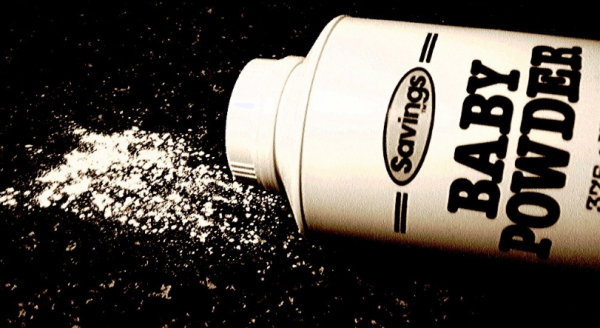 Talcum powder – that baby and personal-care staple used by millions of people for over a century – has been in the news again. Most recently, a woman in California was awarded over $400 million after she filed a lawsuit claiming that her use of baby powder gave her ovarian cancer. In fact, there currently are 300 similar lawsuits pending in that state alone and over 4,500 other lawsuits around the United States. So, if you’re wondering if you should reconsider your use of talcum powder as part of your personal hygiene regimen, you’re not alone.
Talcum powder – that baby and personal-care staple used by millions of people for over a century – has been in the news again. Most recently, a woman in California was awarded over $400 million after she filed a lawsuit claiming that her use of baby powder gave her ovarian cancer. In fact, there currently are 300 similar lawsuits pending in that state alone and over 4,500 other lawsuits around the United States. So, if you’re wondering if you should reconsider your use of talcum powder as part of your personal hygiene regimen, you’re not alone.
As you can imagine, the companies that manufacture talcum powder, and other personal care products, insist their products and their ingredients are all safe when used as directed. They are supported in these claims by a wide variety of experts, academics and even, to a certain extent, such governmental bodies as the Food and Drug Administration and the Centers for Disease Control and Prevention. On the other hand, there are numerous consumer watchdog groups claiming the exact opposite. Namely, that talcum powder and other personal care product ingredients such as lead can pose a health risk even when used as directed. And they, in turn are supported as well by experts, academics and even some government regulatory agencies and researchers.
So, who is right? Should you worry about using talcum powder and other personal care items?
Let’s take a closer look.
Talcum powder was first introduced commercially in 1893 and quickly gained popularity for its ability to help prevent rashes by absorbing moisture and keeping skin dry. It is also a key ingredient in many other consumer products including cosmetics, soap, antiperspirants and drug tablets.
Talc, the key component of talcum powder, is a mineral composed mostly of magnesium, silicon and oxygen, all three of which are harmless and, to varying degrees, necessary for our bodies to function. Where the concern and confusion over the health risks of talc may have arisen is that some talc also contains asbestos, which is a carcinogen when inhaled. Given the health risks of asbestos, all talcum products manufactured for consumer use in the United States have been and continue to be asbestos-free since the 1970s. So, in the unlikely event you happen to have any talcum powder that has been in your home from that time, your best bet is to just throw it out.
While researchers agree that inhaling talc with asbestos (almost exclusively from industrial settings) could cause lung cancer, any potential link between the use of asbestos-free talc and cancer, and especially ovarian cancer, is still not clear. The theory is that talcum powder might cause cancer in the ovaries if the powder were to make its way from various feminine products or personal application in the genital area to the ovaries. Research continues in this area and, unfortunately, findings continue to be sufficiently inconclusive for both sides of the debate to claim they are right. What we do know is that if there is any increased risk associated with perineal application of talcum powder, the overall increase is most likely to be minimal.
Even an international body as prestigious as the International Agency for Research on Cancer (IARC) has not given a definitive opinion. While this body does classify any asbestos-containing talc to be carcinogenic, it’s position on any link of perineal (genital) application of asbestos-free talcum powder with cancer is that this could be “possibly carcinogenic.”
And while other recent research is showing a consistent association between perineal talcum powder use and ovarian cancer, there are many other risk factors that need to be considered such as your age, whether you are pre- or postmenopausal, your weight and whether you smoke or have smoked.
The verdict for consumers? Despite extensive research, the jury is still out on the true risk of using talcum powder for perineal application. So, your best bet is to learn as much as you can about any potential risk, talk with your healthcare provider and make an informed decision as to how much risk you are willing to accept.
The list of ingredients you should check for with personal care products doesn’t end with talc, however. While there are literally hundreds of product ingredients that could be toxic or trigger an allergic response in some people, here are some of the most notable culprits to keep an eye out for:
- Lead – Mostly found in lipsticks, exposure to too much lead can impact learning, language and cause behavioral problems; reduce fertility in both men and women; cause hormonal changes and menstrual irregularities; and delay the onset of puberty in girls and development of testes in boys. To learn more about lead levels in lipsticks, check the FDA’s findings in this table.
- Phthalates – These are man-made chemicals that are used to make plastics, cleaners and fragrances. Frankly, they are still being studied and the full range of their potential effects on your health is still not completely known, the NIH says. Studies on animals have linked phthalate exposure with reproductive and developmental issues. You can look for products that are marked as being phthalate-free and fragrance-free.
- Parabens – Widely used preservatives that prevent the growth of bacteria, mold and yeast in cosmetic products. Sounds good, right? Not so fast, they do more than that. Parabens possess estrogen-mimicking properties that are associated with increased risk of breast cancer. These chemicals are absorbed through the skin and have been identified in biopsy samples from breast tumors. They can be found in makeup, body washes, deodorants, shampoos and facial cleansers. You can also find them in certain foods and pharmaceutical products.
- Sodium lauryl sulfate (SLS) / Sodium laureth sulfate (SLES) – These are used create the bubbles and suds you get when you use soap, shampoo and other skin care products. As innocuous and innocent as that may sound, these compounds can irritate your eyes, skin and even lungs. There is also research that indicates that they could combine with other chemicals to form carcinogens. Keep an eye out for them when shopping for personal cleansers.
- Formaldehyde – The same liquid you remember from biology class to preserve specimens is also used in many personal care items to help prevent bacterial growth. This chemical has been categorized as a human carcinogen and can also cause skin reactions. You will commonly see it is such products as nail polish, eye shadows and conditioners. If you are concerned about formaldehyde, limit or eliminate your use of products that contain it.
Except for some hair dyes, most of the ingredients in your personal care arsenal don’t need FDA approval to hit the shelves. So, it’s up to you be proactive instead of relying on government agencies and regulations. Learn how to scan the fine print on labels to identify possible red flags. In the end, you need to be as informed as you can be in order to make the right decisions for you and your family.
Enjoy your healthy life!





Leave a Reply